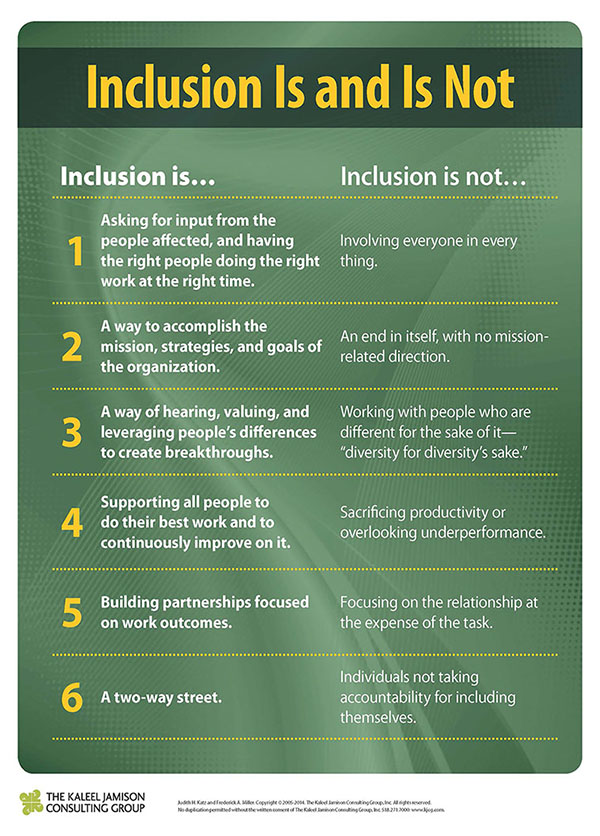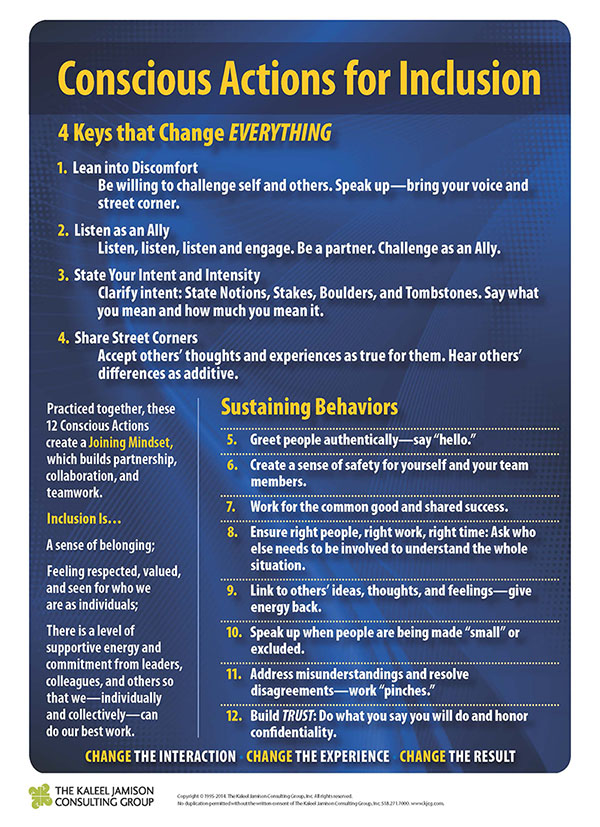Inclusion
Inclusion —What it IS and IS NOT
By Frederick A. Miller and Judith H. Katz
It is rare to come across an organization that does not have an inclusion statement or some internal effort related to inclusion. Many organizations see inclusion having a broader meaning as a platform for higher organizational performance and understand that they simply cannot afford to ignore inclusion.
In more progressive organizations, inclusion is being implemented as a path to competitive advantage—a central business strategy that accelerates organizational performance, builds stronger connections with organizational members and with customers, and produces superior bottom-line results. But even in these organizations, inclusion efforts can be hindered by misconceptions that inclusion is solely “a nice thing to do” that is separate from the core operations of the organization and its performance.
In organizations mired in legacy thinking, inclusion may be seen as indistinguishable from “diversity.” When some people hear the word “inclusion,” they think it means slower decision making, longer meetings, and more time to complete tasks. Others think it means lowering standards or they fear inclusion requires “everyone involved in everything” and a subordination of business priorities to make people feel good. All of these are misconceptions and block the real workplace advantage of inclusion. These assumptions must be addressed to actually achieve the workforce optimization and competitive advantages that inclusion offers.

Inclusion is better understood as a process, as a means to an end—as a HOW—not as an end in itself. To gain the advantages offered by inclusive practices, it is more productive to establish a set of conscious actions that support the creation of an inclusive environment (see Figure 1, Conscious Actions for Inclusion). These conscious actions for inclusion become “standard work” for how people interact and are critically important in providing people with a roadmap for how to engage. While many organizations are focusing on unconscious bias and what not to do, conscious actions for inclusion provide clarity on the behaviors that will move toward greater inclusion. These behaviors, when tied to the mission, vision, and strategies of the organization, yield quantifiable results for customers, stakeholders, team members, and the organization as a whole. In our work, we call this Inclusion as the HOW®. It is an essential driver of higher individual, team, and organizational performance.

Definition of Inclusion
An explicit statement of what inclusion is creates some common understanding and helps organizations and their people understand and practice inclusion in a way that enhances performance and accelerates results. Three key elements stand out as we think about inclusion: that people feel they belong, that their diversity is valued and respected and seen, and, most importantly, that the environment is supportive and enables people to do their best work. However, as important as it is to understand what inclusion IS, it is just as important to understand what inclusion is NOT and dispel myths that create resistance and perpetuate actions that do not align with clear business needs is just as critical (see Figure 2).
1. Inclusion IS NOT… involving everyone in every thing.
Too often people think that being inclusive means “everyone should be involved in everything.” As a result, too many people are asked to attend meetings that are not relevant to their work and are invited to give input on decisions that do not impact them. This not only creates confusion, but is also a substantial waste of people’s time. Meetings and processes become cumbersome and overwhelming. Even more damaging is the backlash that this belief creates. When people struggle with the challenges this misperception of inclusion creates, they are likely to brush it off completely. Some attempt to include everyone, which of course does not work, and they give up. It drives people away from even attempting to be inclusive. They use the fact that they cannot include every single person as justification to keep inviting the same people: the in crowd, the A team, the trusted advisors, the yes people—whoever that exclusive group is.
Inclusion IS…asking for input from the people affected, and having the right people doing the right work at the right time.
What is key to inclusion is that the right people are involved at the right time doing the right work. An organization can demonstrate its commitment to valuing people and their time by seeking input from all individuals affected by the issue/opportunity at hand. This kind of selectivity and careful thinking about who are the right people to be involved in the decision or conversation provides a forum that is indeed inclusive as individuals who need to be in the conversation are sought out and heard. What this also means is that the organization can no longer seek input from the same “go to” people. It requires thoughtful examination of the issue being addressed and who are the key people to include. Hearing from the people affected can help achieve a 360-degree vision of the issue that leads to better decisions. This process can also create a stronger sense of shared investment and accountability for co-creating the best solutions because those involved have added their thinking in the information-gathering/decision-making process. Participants have a stake in the outcome, which strengthens the ability to execute on the decision.
Read more of the article here.
References:
1In The Nibble Theory and the Kernel of Power, Kaleel Jamison described the process of diminishing language, actions, or behaviors, whether directed inwardly at the self or outwardly at others, as “nibbles.”
2Building on concepts in The Nibble Theory in Be BIG: Step Up, Step Out, Be Bold, Katz and Miller describe how we make others “small” and how we can choose to build others and ourselves up to do our best work together.
Jamison, K. (2004). The nibble theory and the kernel of power, 2nd Ed. Mahwah, NJ: Paulist Press.
Katz, J. H. & Miller, F.A. (2013a). Opening doors to teamwork and collaboration 4 Keys that change everything. San Francisco, CA: Berrett Koehler.
Katz, J.H. & Miller, F.A. (2013b) Judging others has not worked…so let’s join them. Leader to Leader, 70 (2013), 51-57.
Katz, J. H. & Miller, F.A. (2008). Be BIG: Step up, step out, be bold. San Francisco, CA: Berrett Koehler.
Katz, J. H. & Miller, F. A. (2010). The Need for Speed: It starts with Interaction. Chief Learning Officer, 9 (6).
Miller, F.A. (2013) Meetings are not a spectator sport. KJCG manuscript.

